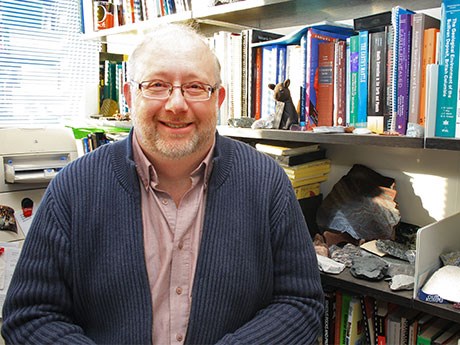Lakehead University in Thunder Bay part of development team
Imagine the time you’d save by accurately mapping a mineral deposit even before you start drilling.
That’s essentially the technology being developed right now in a collaboration between Lakehead University and its partners the University of Tasmania, the Imperial College London, the Natural History Museum (London), and AMIRA International.
The research is so compelling that it won the prestigious Institution of Engineering and Technology (IET) Innovation Award in the “Measurement in Action” category last November.
Perhaps more telling is the fact that there are currently about 21 industry sponsors involved with the project making it the largest geoscience project AMIRA has ever had, said Peter Hollings, chair of Geology at Lakehead University in Thunder Bay.
“There has been quite a bit of interest from industry over the years,” Hollings said. In Canada, the list of sponsors includes Barrick, Inmet, Eldorado Gold, First Quantum and Teck. “The companies have seen the value in what we’re doing.”
Geochemical changes
The process analyzes the geochemical changes in the halo formed around porphyry deposits to infer things like the size and location of the mineral deposits. Samples can come from surface rocks, making collection much easier. These samples are prepared for testing by forming small “pucks” about an inch in diameter.
Laser ablation inductively coupled plasma mass spectrometry (LA-ICP-MS) is used to get a better picture of the minerals and elements present in each sample.
“Traditional methods would analyze a whole rock, get some geochemical changes, and sort of try to guess the size of the system,” Hollings said. “What we’ve done that is different is by using laser ablation technology, we can analyze trace elements at much lower levels and we can analyze different trace elements in minerals (compared to traditional methods).”
Using this technique, geologists can increase the size of the recognizable halo to give companies a bigger target to aim at, and find indicators of proximity to the centre of the deposit. Ultimately, it will provide a level of detail that other techniques can’t provide.
“In some cases, we can even tell you which direction we think it is to the centre of the deposit. We’ve also come up with what we call fertility indicators which are ways of suggesting how big the deposit is,” since the geochemical response of a smaller deposit is different than that of a big deposit, he said.
The biggest advantage of the technique is that it is a faster and more cost-effective method of finding targets, increasing the efficiency of the whole exploration process.
“Probably at the end of the day it won’t reduce the amount of drilling a company actually does, but it will allow them to target their drilling more efficiently so that they’ll have fewer holes that don’t work and more holes that take them in the right direction,” Hollings said.
It will be another tool in the exploration toolbox. “We’re not saying that this is going to replace mapping or aeromagnetic surveys or drilling, but it’s one way of doing those things more efficiently, shortening the point from discovery to development.”
From Lakehead’s perspective, it is also an incredible learning opportunity for its students. During the three-year project, students travelled to several locations, including British Columbia, Utah, and the Philippines to collect samples. Then it was off to the Australian Research Council’s CODES Centre of Excellence in Ore Deposits, a global leader in ore deposit research at the University of Tasmania where they learned how to prepare the samples and conduct the laser ablation themselves under the tutelage of CODES researchers.
This type of partnership provides invaluable international learning opportunities for the students. “Doing it through this AMIRA project is really good for the students because they get all the exposure to the companies and world experts,” Hollings said. “They can interact, learn from, and be in the field with some of the best people for different deposit types.”
Right now, the technique only works with porphyry systems, so there are few applications within Northern Ontario. Future projects will examine different styles of mineralization systems to see if the techniques are transferable.
“We think it might work with orogenic gold deposits which are mines like Musselwhite or Red Lake where there’s still this fluid system. But it won’t work with things like most of the Sudbury deposits where the mineralization is crystalized internally within a magma chamber. You have to have fluids coming off away from mineralization for this to work,” Hollings said.



